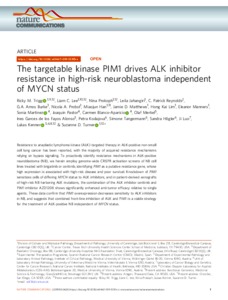Trigg, Ricky M and Lee, Liam and Prokoph, Nina and Jahangiri, Leila and Reynolds, C. Patrick and Burke, G. A. Amos and Probst, Nicola A and Han, Miaojun and Matthews, Jamie and Kai Lim, Hong and Manners, Eleanor and Martinez, Sonia and Pastor, Joaquin and Blanco-Aparicio, Carmen and Merkel, Olaf and Garces de los Fayos Alonso, Ines and Kodajova, Petra and Tangermann, Simone and Högler, Sandra and Luo, Ji and Kenner, Lukas and Turner, Suzanne D
(2019)
The targetable kinase PIM1 drives ALK inhibitor
resistance in high-risk neuroblastoma independent
of MYCN status.
Nature communications, 10.
ISSN 2041-1723
![[img]](/8672/1.hassmallThumbnailVersion/s41467-019-13315-x.pdf)  Preview |
|
Text
s41467-019-13315-x.pdf
- Published Version
Download (1MB)
|
Abstract
Resistance to anaplastic lymphoma kinase (ALK)-targeted therapy in ALK-positive non-small cell lung cancer has been reported, with the majority of acquired resistance mechanisms relying on bypass signaling. To proactively identify resistance mechanisms in ALK-positive neuroblastoma (NB), we herein employ genome-wide CRISPR activation screens of NB cell lines treated with brigatinib or ceritinib, identifying PIM1 as a putative resistance gene, whose high expression is associated with high-risk disease and poor survival. Knockdown of PIM1 sensitizes cells of differing MYCN status to ALK inhibitors, and in patient-derived xenografts of high-risk NB harboring ALK mutations, the combination of the ALK inhibitor ceritinib and PIM1 inhibitor AZD1208 shows significantly enhanced anti-tumor efficacy relative to single agents. These data confirm that PIM1 overexpression decreases sensitivity to ALK inhibitors in NB, and suggests that combined front-line inhibition of ALK and PIM1 is a viable strategy for the treatment of ALK-positive NB independent of MYCN status.
Actions (login required)
 |
View Item |

 Tools
Tools Tools
Tools